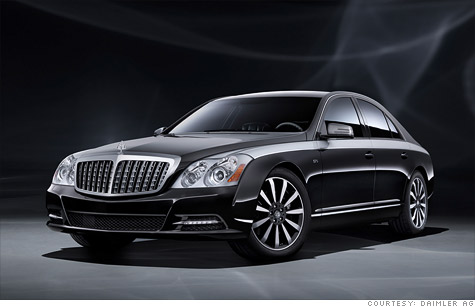
FORTUNE -- Ending almost a decade of losses, Daimler is shutting down its super-luxury Maybach brand. It would not make sense to develop a successor model," chairman Dieter Zetsche said to the German newspaper Frankfurter Allgemeine Zeitung. "The coming S-Class is in such a way a superior vehicle that it can replace the Maybach."
Zetsche will be glad to wipe his hands of Maybach (pronounced MY-bock). It was one more embarrassment -- like the money-losing Smart car and the failed Chrysler merger -- left over from the reign of his grandiose predecessor, Juergen Schrempp. Maybach has been hanging around for years while Zetsche, who clearly had little respect for the brand and dismissed it as financially inconsequential, dealt with more pressing problems.
The Maybach epitaph will not be a not pretty one. It was a remarkably cynical effort by Daimler to use the halo of its Mercedes-Benz brand to justify prices of $350,000 to $1.4 million for an inferior automobile wrapped in a glitzy package. Maybach strived for a prestige that it tried to ground on price alone. The wealthy figured it out in a hurry and stayed away in droves. Appearances to the contrary sometimes notwithstanding, the top 0.0001% didn't accumulate all that money by being stupid.
Here's the Maybach back-story: When Rolls-Royce and Bentley came up for sale at the end of the 1990s, Mercedes decided to pass. One executive said at the time, "At the end of the day, we said we didn't want to play this game. The price was too high."
Mercedes's German rivals did want to play, however. BMW wound up with Rolls, and Volkswagen got Bentley. Fearful of being left out of the high status game, Mercedes backpedaled and decided it needed to be in the ultra-luxury business too, but it went after it in a remarkably clumsy way.
Rather than develop a new car from the wheels up, as BMW did with Rolls-Royce, or cleverly use the underpinnings of an existing model like the Audi A8 for a new Bentley, Mercedes took an aging S-class chassis and plopped an absurdly elongated body on it. A top-of-the-line auto was born: more than 20 feet long with all the grace of an Airstream trailer.
The next piece of business was to find a name for this ungainly creation. Borrowing a patina of history and heritage, Mercedes decided to name it after a German engineer named Wilhelm Maybach, who had produced a line of limousine-size cars in the '20s and '30s. He later collaborated with Graf Zeppelin to design and produce engines for the airships that bore his name. Mercedes toyed with the name "Maybach Zeppelin" but sensibly decided the blimp connection might not be a positive one.
Since "Maybach" was not exactly a household name like Daimler or Ferrari, Mercedes worked overtime to create some personality for its cars. Customers were expected to equip their autos the way they would a yacht, spending hours selecting fabrics, colors, hides, and woods.
Determining exactly how much customers were willing to pay for this kind of extravagance required some research. Mercedes flew the concept car to Hong Kong, Monaco, and New York City to poll potential buyers. It discovered that customers may not have been very price-sensitive, but they did appreciate a bargain. Some even asked for freebies -- like a $115,000 Mercedes SL roadster -- to be included with their purchase.
Mercedes brought Maybach to market with a splash in 2002. For the U.S., it shipped the first car to New York on the deck of a ship and lifted it by helicopter to a landing place near Wall Street. The aging daughter of Wilhelm Maybach was enlisted to appear at various promotional events. The atmosphere was frothy. "Based on our research, there are enough customers who are able to afford such a car," said Joachim Schmidt, head of Mercedes's sales and marketing. "If you deliver something very special, then you have a chance to sell 1,000 cars."
Not special enough, apparently. The Maybach turned out to be a very expensive limo. Bentley and Rolls had histories behind them, and while the Rolls customer expected to be driven in his car, he could, in a pinch, drive it himself. Maybach never made a pretense of being an owner-driven vehicle. Automotive journalists, many of whom insist upon sitting behind the wheel before making a positive judgment on a vehicle, were offered rides as passengers instead. All the action was in the rear seats that reclined like those in an airplane's business class, with pillowed headrests and extended footrests. The lucky rider could access in-car refrigerators, cigar humidors and other appurtenances thought to be essential for membership in the upper classes.
It just didn't compute. Even the booming luxury car market in China wasn't enough to move Maybach off the starting line. It quickly became apparent that the brand was in trouble, and Mercedes sensibly never invested in updating the model line. In 2010 only 157 Maybachs -- from a brand nearly a decade old -- were sold globally, according to Automotive News, while BMW moved 2,711 similarly priced Rolls.
With Maybach put to rest, Mercedes won't be abandoning the ultra-luxury segment. It plans to expand its top-of-the line Mercedes segment -- the S-Class -- to six variations from the current three when a new generation of the flagship model is launched in 2013.
One hopes that it doesn't decide to name them after a guy who designed blimps. ![]()